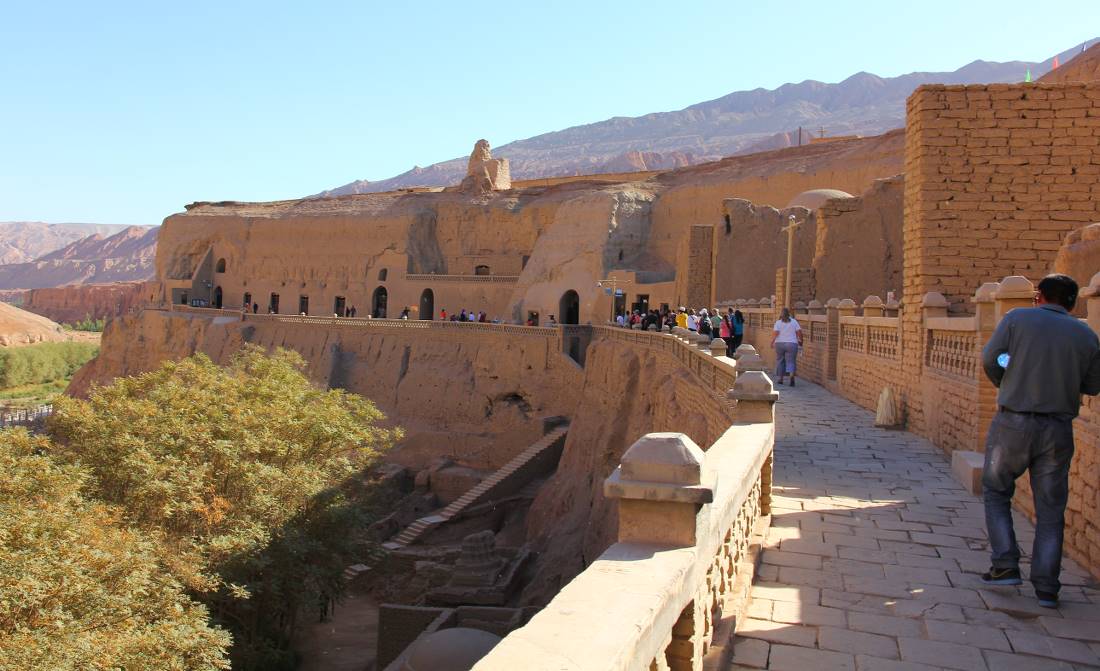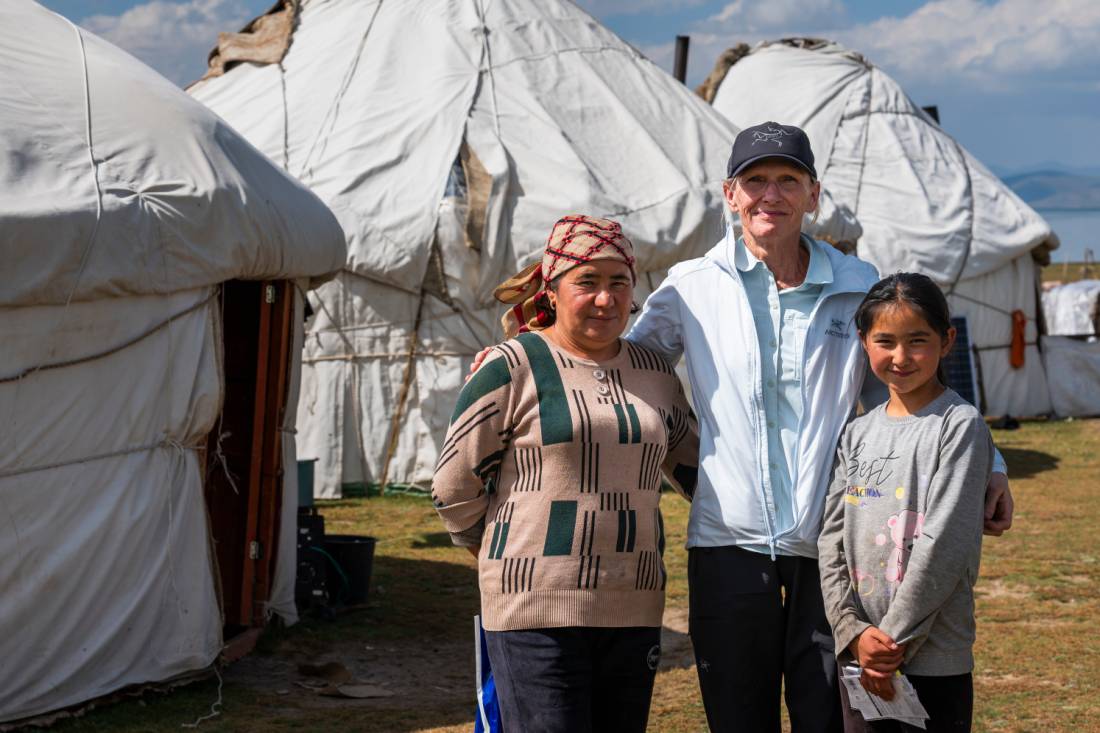Blog home / 10 hidden highlights of the Tian Shan Mountains
Many of our pioneering trips to Kazakhstan, Kyrgyzstan and China take in the Tian Shan Mountains of Central Asia, with its varying landscapes, high passes, stunning lakes and the spectacular pyramid of Khan Tengri.
There are plenty of spectacles and experiences to unfold in this ‘heavenly’ mountain range. To give you an introduction, we have pulled together our pick of the 10 best spots for your next 'out there' adventure.
1. Issyk Kul Lake

Lake Issyk-Kul is the second largest alpine lake in the world, after Lake Titicaca in South America. Measuring 182 km long by 58 kilometres wide, the lake appeared as a result of volcanic activity, heated underground by thermal springs and never freezes – even in the depths of winter!
Extremely deep and pleasantly warm, over the centuries the lake has been something of an oasis in this inhospitable mountain environment. In the summer, the water temperature reach 25-28°C, warmer than the air.
With diverse flora and fauna, Issyk-Kul Lake and the surrounding environment are rightly considered to be one of Central Asia’s most remarkable locations.
2. Charyn Canyon
200 kilometres east of Almaty lies the Charyn Canyon. In close proximity to the Chinese border, it is part of the Charyn National Park, established in 2004. The canyon stretches 154 kilometres along the Charyn River in the northern Tian Shan Mountain range. A strikingly beautiful place, the canyon is known for its unusual rock formations and bears semblance to some of the great canyons found in western USA.
3. High-Altitude Mountaineering
Enjoy epic fully supported mountaineering expeditions in the Tian Shan range. Experienced mountaineers can summit several 7000+ metre peaks and others can enjoy impressive views from lower grounds.

On a mountaineering expedition in the Tian Shan Mountain Range, your fitness, mental toughness and technical capacity will be put to the test, rewarded with a climbing expedition beyond the ordinary. You’ll most likely set up camp in snow caves, immersed in true wilderness.
4. Jeti-Oguz Gorge

Jeti-Oguz translates from Kyrgyz as ‘Red Cliffs of Seven Bulls’ and is set at the height of 2,250 metres above sea level on the northern slopes of the Terskei Ala-Too Ridge. The slopes of the gorge are covered with the world-famous Tian Shan blue spruce and form a fantastic mountain wood to trek through.
With a fast mountain river flowing parallel to the trail and a stunning waterfall named 'Maiden Tears', imagine spending the night in a traditional yurt with the red cliffs and green conifers as a backdrop.
5. Bezeklik Thousand Buddha Caves
Picturesquely located on a cliff face overlooking a river valley are the ancient Bezeklik Thousand Buddha Caves. In the Chinese part of the Tian Shan Mountains, you can visit the caves on your way to or from Urumqi, about a three-hour drive apart.

Situated at the foot of the Tian Shan Mountains, Urumqi is the capital of the Xinjiang Uygur Autonomous Region.
6. Local interactions with nomads
Spend the night in a yurt camp in summer mountain pastures and on the shore of Son-Kul Lake. It is where Kyrgyz nomadic families live as their ancestors have for generations. Perhaps you will be offered to sample fresh airan (yogurt) and kumis (the national drink of fermented mare’s milk), or maybe the locals will teach you how to set up a yurt?

The yurt is the traditional shelter for people of the Tian Shan Mountains. The nomadic dwellings are constructed of a multi-pieced wooden frame that is overlaid with several felt coverings of sheep wool. It takes only about two hours to put together with many colourful handmade mats, felt rugs and embroideries to be found inside, as well as a ‘dastorkon’ – a low table with delicious food prepared for guests.
7. Heavenly Lake

From Urumqi, it is a nice drive to one of the most impressive sights in China, Tianchi, or Heaven’s Lake. The deep blue lake is set amid the Tian Shan Mountains below the imposing Bogda Peak (5,445 metres) and is framed by fir trees and mountain peaks. You’ll often find it sprinkled with yurts and Kazakh nomad summer camps.
8. Karkara Valley
On the border between Kazakhstan and Kyrgyzstan, lies the beautiful Karkara Valley. This area was once part of the Silk Road, traversed by Kazakh, Kyrgyz and Chinese traders. Nowadays, the spot is reserved for Base Camp Karakara – the jumping-off point for expeditions to summit Pobedy Peak (7,439 metres) and Khan Tengri (7,010 metres). For those that are visiting the Tian Shan Mountains, the camp may be a welcoming break. Accommodation is in a “walk-in” tent and comes with hot showers, a traditional sauna and a bar!
In the valley, you may meet the nomads who have brought their flocks up to this fertile land, perhaps taste some local tea inside a yurt, or chat with the horsemen and try your hand at milking a horse.
9. Cholpon Ata Petroglyphs
Close to the shore of Issyk Kul Lake, you’ll find the site of the Cholpon Ata Petroglyphs. Set at the foot of the Kungei Alatau Ridge, they form an interesting cultural stop on a trip in the Tian Shan Mountains.
Most of the petroglyphs date from the Saka-Unsun time (8th century BC – 1st century AD) and were made by Saka priests for sacrifices and other rites. There are also more recent engravings from the Turkic era, with the most beautiful one depicting several ibex being hunted by snow leopards. You’ll have a nice view of Issyk Kul Lake from the site.
10. Golden eagle hunting history
Golden eagle hunting is one of the oldest methods of hunting for food. Central Asian ancestors in the Eurasian steppes mastered the art of eagle hunting several thousand years ago, in the Andronov age. Eagle hunting was mainly practised in the northern and central regions of Kazakhstan. Golden eagles usually catch corsacs and hares, while the stronger, well-trained eagles proved useful for hunting hoofed animals and even wolves. Near Karkara Base Camp, you can visit an eagle hunting museum to learn more about this ancient hunting method.
Feeling inspired? View our range of adventures in the celestial mountain ranges of Tian Shan.